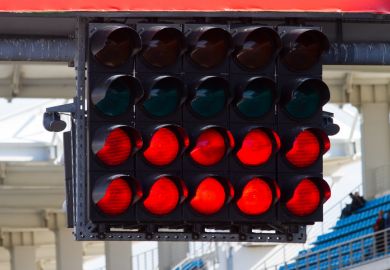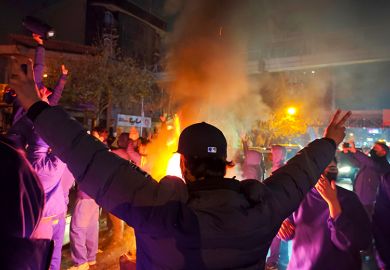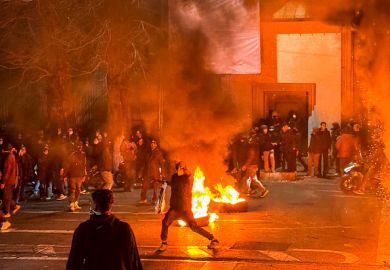Source: Getty
To deal with the fire in the hours and days afterwards…we had to put people back into a situation where they had to confront the source of their trauma
Accidental disasters: Fire
When fire ripped through Glasgow School of Art’s historic Mackintosh building, students looked on in horror.
In May last year, years of work went up in flames, just weeks before final assessments and the all-important degree show.
Some lecturers lost even more, having worked in the building for several decades.
And the destruction of much of the building’s famous library and its original furniture, designed by Charles Rennie Mackintosh, caused concern around the world.
As the flames engulfed the building, archivists suppressed their emotions and provided firefighters with detailed descriptions of Mackintosh furniture, in the hope of saving it from the inferno, which was thought to have been caused by flammable gases from a canister of expanding foam.
Then, in the days after, there was the painstaking process of identifying and salvaging the surviving work of staff and students from the wreckage.
This, says Tom Inns, the school’s director, was one of the most difficult aspects of the disaster to deal with.
“To a certain extent we needed the skills, expertise and knowledge of those people who had been most directly affected in order to deal with the fire in the hours and days afterwards,” says Inns. “We had to put people back into a situation where they had to confront the source of their trauma.”
In that difficult time, the school’s critical incident management plan proved “invaluable” in getting the necessary structures in place in the first 12 hours, says Inns.
An incident room was set up in another school building, counselling was provided for staff and students, and the job of dealing with the international media interest got under way.
The more complex challenge was to decide how to ensure that students whose work had been lost did not suffer further.
Using photographic records and assessment histories, staff had to judge the likely trajectories and final grades of students.
In an art school, however, the degree show can be more important for a student’s future career than their degree classification, but this clearly could not go ahead as normal.
Instead, each student was allowed to exhibit one digital image of their work at a “showcase” event. Then, using bursaries funded by the Scottish government and private benefactors, students took up residencies at other institutions across the country, producing a new body of work.
This will be the focus of a forthcoming show, giving graduates the opportunity to launch themselves on the art scene, which they would otherwise have missed.
The school’s recovery continues, with the focus now shifting to the reconstruction of the Mackintosh building.
A shortlist of architects has been announced and a fundraising campaign is under way, with the aim of reopening much of the building for the 2017-18 academic year.
The school is “determined”, says Inns, to restore the Mackintosh building to how it was before the fire.
He acknowledges, however, that the small size of the school has made an incident of this scale particularly problematic.
“One of the biggest challenges has been not to allow this to deflect us too much from our strategic ambition,” says Inns. “Otherwise we would have lost ground, so we have had to be pretty fleet of foot with the changes it has forced on the institute.”
Inns is thankful for the comprehensive level of insurance that the school had in place, including business continuity cover.
Some institutions, particularly those with large estates, have limited cover, he says, because the premium is so expensive. But Inns argues that institutions should view it in the same way as domestic insurance.
“If you reflect on what the consequences of an incident could be, you realise that the cost can be extremely high,” says Inns.
There is also a broader lesson, perhaps, for institutions that are custodians of historic estates. Although the Mackintosh building was one of the best-documented in the UK, there is still additional information that the school would have liked to have had available for the rebuild. And when it comes to rebuilding, the school will look closely again at fire protection systems.
Another institution that had to cope with a devastating fire was the University of Nottingham, where the £20 million GlaxoSmithKline Carbon Neutral Laboratory for Sustainable Chemistry was destroyed in a blaze last September.
The wooden-framed building was 80 per cent complete, but protection equipment, such as fire doors, was yet to be installed.
Paul Greatrix, Nottingham’s registrar, recalls how the fire had broken out just hours after an exercise that simulated a major fire elsewhere on the university’s estate.
He swiftly made the decision that going to the campus that evening would achieve little, so his staff followed their incident plan remotely. Students were reassured, the media was communicated with, and the decision was made that an open day scheduled to attract 20,000 people the following day would go ahead.
The key area of learning, Greatrix argues, is about the power of social networking, particularly Twitter, during major incidents – both for the university to communicate its message, and to counter misinformation.
The fire was caused by an electrical fault, and the university is adamant that its contractors met health and safety requirements.
Rebuilding work has already begun, but Greatrix says that the design will be modified to make the laboratory a “much safer building in future”.
He adds: “We will obviously be infinitely more careful and wary during that critical stage [of building] when we get to 80 per cent [complete].”
Greatrix is grateful that, unlike in Glasgow, no staff were based in the building, and no research was lost.
Both Inns and Greatrix highlight the way that an educational community pulls together in these cases – and the level of support received from elsewhere in the sector.
“At times of genuine crisis like this, people come together and are very supportive and positive and are willing to work together for the common good, regardless of the size of the institution,” says Greatrix. “That shows the best of higher education.”
Chris Havergal
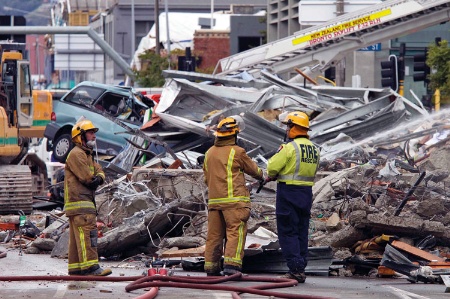
Students can get a first-hand account of what earthquakes can do - and not just to buildings. They will also see the extent of other social impacts
Natural disasters: Earthquakes
On 22 February 2011, an earthquake measuring 6.3 on the Richter scale hit Christchurch, New Zealand, killing 185 people. Four of the dead were students or recent graduates of the city’s University of Canterbury.
The institution sustained significant damage in the earthquake, which had been preceded six months earlier by an even larger earthquake – although the September 2010 event did not claim any lives. In the aftermath of the second quake, some 30,000 sq m of its 260,000 sq m estate was deemed out of bounds, including lecture theatres, the library and the students’ association building.
Five years on, the university is still dealing with the consequences. It was only in December of last year that the institution agreed to an earthquake insurance settlement offer of NZ$550 million (£266 million) for rebuilding on campus.
According to the New Zealand Herald, the Canterbury earthquakes “damaged university buildings and scared off students”, resulting in a NZ$114 million loss in 2010-11. Insurance reimbursements made up NZ$40.7 million of the NZ$188 million that the university generated in the first six months of last year.
Student numbers have fallen from more than 18,000 in 2011 to some 11,000 today.
In the university’s March 2014 newsletter, vice-chancellor Rod Carr put the number of students at the institution at “almost 10,900” – slightly fewer than the previous year. Despite the dip, he described this as “really promising”. “We have always known that rebuilding student numbers would not be a one-year project and further efforts will be required in this area as we work towards our first post-quake surplus by the end of 2017.”
A NZ$1.1 billion capital investment programme is currently under way, and more than a dozen major buildings have now been reopened. The New Zealand government has contributed NZ$260 million towards redeveloping the institution’s science and engineering projects, and students will return to the city centre’s historic arts centre this year.
According to Hamish Cochrane, deputy vice-chancellor (academic and international): “Our staff have demonstrated amazing adaptability while delivering high-quality teaching and research.” He points to “record or near record numbers of new, enrolled and completing doctoral students” as evidence that the earthquakes “have advanced rather than set back our research programmes”.
The earthquakes have also led to the forging of links with overseas institutions. Two weeks after the second earthquake, 170 Canterbury students travelled to Australia, where they were taught at the University of Adelaide, and many local families offered homes for the students to stay in.
One of those students, Ben Melville, was in the second year of his computer science degree. He has now graduated and works as a web developer in the University of Adelaide’s web team. “After the earthquake, I was worried that it would affect my degree and that it would take longer to finish,” Melville says. “The welcome was amazing from both staff and students – really hospitable and helpful. We had a great time and I was also able to study some programming languages that I wouldn’t have in New Zealand, which opened up my opportunities.”
And students from Adelaide have travelled in the other direction. Last year, 43 final-year structural engineering students from the Australian institution got to see for themselves the impact of earthquakes during a two-week course at Canterbury.
“This is a tremendous opportunity for the students to receive a first-hand account of what earthquakes can do – not just to buildings but also to a city and region and its ability to function. They will also see the extent of other social impacts,” said Mike Griffith, professor of structural engineering in Adelaide’s School of Civil, Environmental and Mining Engineering, when the project was announced last July.
“They were able to see the extent of the demolition necessary in the central business district and the large residential subdivisions rendered unliveable, as well as the design features being incorporated into new buildings and the state-of-the-art approaches being used to repair bridges, port facilities and culturally significant buildings,” Griffith explained.
Other universities devastated by earthquakes include Kocaeli University in Turkey, which lost nearly 75 per cent of its buildings after a huge earthquake in 1999, while Tohoku University in Japan put the cost of the massive 2011 earthquake at ¥107 million (£600 million).
After the Japanese disaster, about 1,200 of Tohoku’s 1,500 international students left the region, but the university says that more than 90 per cent of them returned, along with 99 per cent of postgraduates.
The institution has set up an interdisciplinary research base for tackling issues relating to earthquake and tsunami countermeasures and nuclear energy risk management, the funding of which was supplemented by ¥34 million of government money.
Writing for the Japanese Embassy in the UK after the magnitude 9 tremor, Toshiya Ueki, executive vice-president of Tohoku, said that “the disaster has opened up new research fields such as regional renewal and nuclear energy risk management. In order to tackle the challenging situation we face, we at the university are set upon overcoming adversity and forging a new direction.”
Chris Parr
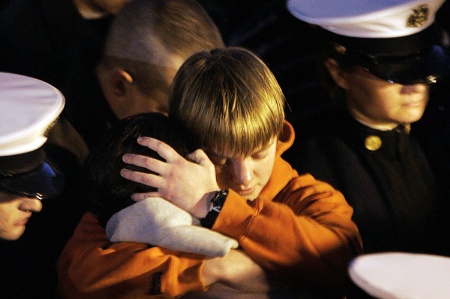
Taking the gun out of the hands of an individual planning a shooting is one approach; having armed officers neutralise an attacker is another
Human disasters: Massacres
“He was sitting up there for more than an hour/Way up there on the Texas Tower/Shooting from the th floor,” sings country singer Kinky Friedman in his 1973 The Ballad of Charles Whitman.
The tower in question was the clock tower of the University of Texas at Austin, and the song details the infamous 1966 massacre in which Whitman, an engineering student at the southern US institution, shot dead 16 people on campus and wounded more than 30 others.
It remained the deadliest shooting on a US college campus for more than 40 years, until the so-called Virginia Tech massacre in 2007, in which undergraduate Seung-Hui Cho shot dead 32 people at Virginia Polytechnic Institute and State University.
Tragically, there have been many other US college-related shootings since then. Last year Elliot Rodger stabbed three of his housemates to death, all of them University of California Santa Barbara students, before going on to shoot and kill three other UCSB students near the institution’s campus, and injuring 13 others. In other incidents, a former student of Oikos University – a small Korean Christian college in California – killed seven people on campus in April 2012, and in February 2008, five were killed and 18 wounded when Steven Kazmierczak opened fire at his alma mater, Northern Illinois University.
“Campus shootings continue to occur because a very small percentage of individuals who are motivated to perpetrate these tragedies exist in the general population,” says Michael Sulkowski, assistant professor in the University of Arizona’s department of disability and psychoeducational studies, who has researched contemporary responses to violent campus attacks in the US.
“If a university’s student body is as large as 40,000, at any given time, at least a handful of students will be in a state of crisis and in need of evaluation and support,” Sulkowski predicts.
In multiple cases, the perpetrator of a violent university attack is a current or past student who has exhibited behaviour that demonstrated violent tendencies, and “usually these individuals exhibit some warning signs that their behaviour is becoming more dangerous; however, these warning signs often are missed”. Whitman, along with two friends, had butchered a deer in the shower of his university accommodation; Cho had been ejected from a poetry class for writing obscene, violent poems.
Although behaviour is very difficult to predict, could more be done to forestall such incidents? According to Sulkowski, “threat assessment” approaches, where a systematic evaluation of vulnerable students is carried out by highly trained mental health professionals with a background in understanding psychopathology, are currently considered best practice, but unfortunately universities do not always have regular access to such expertise.
When the worst does happen, universities have tried to ensure that lessons are learned. Scott Geller, alumni distinguished professor in the Center for Applied Behavior Systems at Virginia Tech, published a paper in the journal Traumatology titled “The Tragic Shootings at Virginia Tech: Personal Perspectives, Prospects, and Preventive Potentials” in 2008.
Geller was driving to work on the day of the massacre when he received a phone call instructing him to “go home…a gunman is loose on campus”. In the paper, he recalls how the day after the shooting, 10,000 students, academics and staff gathered at the university’s basketball arena to pay their respects to the victims and to support each other. The shooting, and the university’s response to it, inspired him to found the Actively Caring for People movement, which encourages students to recognise and reward colleagues who go beyond the call of duty to help their peers. He hopes to foster a collegial attitude within the university – a “culture shift” that will encourage more unity on campuses.
When it comes to preventing future incidents, Geller has a straightforward answer: “Remove guns from our culture. Countries who have done this do not have our problem.”
He points to the indisputable parallel between the prevalence of shootings in US universities and its stance on gun ownership. United Nations Office on Drugs and Crime data put the number of annual firearm-related homicides in the US at 9,146, compared with 41 in England and Wales. After the Sandy Hook massacre of schoolchildren in Connecticut in 2012, hundreds of American college presidents backed the campaign for a ban on assault weapons and for more background checks for gun buyers.
While “taking the gun out of the hands of an individual planning a shooting is one intervention approach”, says Sulkowski, “having armed police officers or concealed…bystanders intercept and neutralise an attacker is another”.
Armed officers on campus are the norm in the US. According to a 2015 Bureau of Justice Statistics report, Campus Law Enforcement 2011-12, about 75 per cent of US campuses had armed officers in the 2011-12 academic year, compared with 68 per cent in 2004-05 (several years before the Virginia Tech shooting). The percentage of public campuses using armed officers (91 per cent) was significantly higher than that of private institutions (36 per cent).
The report also found that “all but a few” campuses had developed “sophisticated mass notification systems”, using email, text messages and other methods to contact students and staff in an emergency.
Policing can go wrong, too, however, leading to a breakdown of trust. One of the most high-profile examples of this occurred in November 2011 at the University of California, Davis, when a group of students protesting in a demonstration held as part of the Occupy movement were pepper-sprayed by a campus officer. Pepper spray causes pain and temporary blindness. The university eventually settled a federal lawsuit by paying $1 million (£657,000) to the students. In 2013, it emerged that the officer responsible received $38,000 in worker’s compensation after he was fired.
The university’s pepper spray incident task force made a series of recommendations, and the institution has since established an independent Police Advisory Board to investigate complaints and a “cadet program” for students to learn about police work, with some graduates of the programme now employed as campus police officers.
Despite this, Scott Shershow, professor of English at the West Coast institution, is critical of the university leadership’s response to the outcry, pointing out that “campus police are still heavily armed”.
In the UK, concerns about heavy-handed police responses to student protest and about police surveillance have led to demonstrations held under the slogan “Cops off Campus”. UK universities have also “been inviting counter-terrorism police officers on to campus ostensibly as part of a strategy to prevent terrorism”, says Nadine El-Enany, lecturer in law at Birkbeck, University of London, who says this is “a precursor to the obligations that are set out in the counter-terrorism and security bill”. The controversial bill – which has been fast-tracked through Parliament – has attracted strong criticism from vice-chancellors and academics, with Anthony Forster, vice-chancellor of the University of Essex, warning that it will make universities “agents of the state”. A total of 24 university leaders urged the government to exempt universities from the bill, and more than 500 professors described it as “unnecessary and ill-conceived”.
Chris Parr
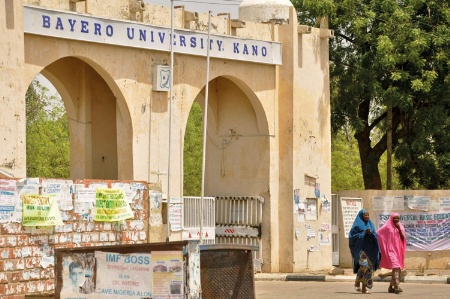
Recovery positions: Finding communal strength after a massacre
“Having recovered from a disaster does not make a community immune,” write two academics in a paper produced in response to a massacre at their institution, Bayero University Kano in northern Nigeria, in 2012. “It is important to be in a state of preparedness consistently.”
In “Man-Made Disaster and Community-Based Recovery Efforts: The Experience of Bayero University”, Murtala Sabo Sagagi, professor of business and entrepreneurship at Bayero, and Esther Ibijoke Oyeyi, a professor in the department of biological sciences, explain what the institution learned from the tragedy, when about 20 staff, students and associates of the institution were killed by an Islamist terrorist group who targeted the institution using automatic rifles and improvised explosive devices.
“In the morning hours of the day, Christian worshippers in the university were attacked and 18 of them were murdered – many were professors, some were students, some were friends of the university who had come to what was supposed to be a safe environment to worship on Sunday,” the institution’s vice-chancellor, Abubakar Rasheed, told Times Higher Education last year.
The paper explains that in the years after the attack, the university embarked on a community outreach programme to repair the damage done to the reputation of the institution as a result of the incident. “In view of the massive media coverage of the attack, it took a [long] period to persuade foreign visitors to visit the university,” the authors say.
In the immediate aftermath, the university constructed stronger perimeter walls, re-equipped and retrained security personnel, purchased metal detectors and improved street lighting. Plans are in place to implement more modern communications technology and cultivate a closer partnership with state security agencies.
The university “defied” the attackers’ motives, the authors conclude. “Rather than polarize the university community along religious divides, it has made the community stronger, more supportive and focused on turning the disaster into a new phase of development,” the paper says.
Chris Parr
Register to continue
Why register?
- Registration is free and only takes a moment
- Once registered, you can read 3 articles a month
- Sign up for our newsletter
Subscribe
Or subscribe for unlimited access to:
- Unlimited access to news, views, insights & reviews
- Digital editions
- Digital access to THE’s university and college rankings analysis
Already registered or a current subscriber?


